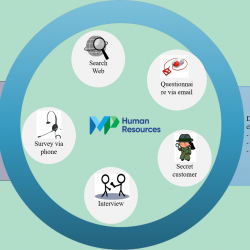At work, there will always be an individual who makes you feel uncomfortable, unfit, or unhappy about something. If this individual is under the control of another person, or in another group, it is okay, but unfortunately if you are the manager of this person.
If you are struggling yourself with this sensitive situation, this is the time to contemplate the following four steps:
STEP 1: UNDERSTAND WHY YOU DO NOT LIKE THIS person
If you really do not like someone under your management, it is important to know the reason why, before doing anything. “The best case is that you do not like them because of the job, but in some cases, the reason is completely natural,” says Keri Higgins-Bigelow, CEO and president of LivingHR. personal. Maybe you do not like someone because they always rush into your office and talk for too long, always make noise when talking on the phone, just like talking about yourself, or constantly express your political views. ”
Higgins-Bigelow says that when training managers to handle similar situations, she discovers that the most common reason that managers do not like someone is often due to their attitude toward work. that person, not personal hatred. Perhaps these people did not actively participate in their group, refuse to improve their performance or lack of interest in the work.
On the other hand, sometimes hatred is also personal. Psychologist Katy Caselli said, “Many of the conflicts at work are due to differences in style or temperament. Knowing myself, knowing I can help ease the conflict. ”
Higgins-Bigelow suggests that you should consider changing your perspective: “In life, there are people we will love so much but we never want to work with them. They can be completely different people at work and off the job. ” If the relationship is not too serious, sometimes changing your perspective will bring great effect.
STEP 2: REMEMBER THAT YOU ARE A LEADER
Now that you know exactly why you do not like the other person, it’s important to figure out how you can still do a good job despite negative emotions. Anyway, you are still their superiors. Higgins-Bigelow suggested: “Remember to always keep a professional touch. Managing and leading a team is not very relevant to your personal interests, but about how you are developing your own and your team. ”
According to Higgins-Bigelow, the best thing you can do is act as a leader. “We spend a lot of time training our newly promoted managers on how to create a better job experience for their subordinates. As superiors, you have to help them fulfill their roles well. You do not have to like them to give them the necessary feedback. Make sure they understand your expectations, and you are always there to help them develop and do the job well. ”
There will always be good solutions to deal with your negative thoughts about others. In fact, you can even turn them into an advantage of yourself. “The key thing here is to study the behavior of people you do not like, and to determine what behavior is due to their personality, and what behavior is due to poor skill in the delivery,” said Caselli. or working style. ”
“Personality differences should be respected, because having different ways of thinking in the long run will lead to better solutions.” On the other hand, the problem of poor working style should be addressed by providing effective feedback. When you think things are going in this direction, things will become much simpler. Group of ecstatic business partners looking at camera with raised arms
STEP 3: READY FOR READING
If everything is still tense after you’ve done step 2, it’s time to address the problem directly to the other person – because they may be afraid to talk to you. Caselli explained: “Managers need to be the ones who start the conversation to improve the situation.”
“For example, one of the best remedies is to set up a private appointment, and start exchanging your thoughts about the strengths and contributions of the other. Then end the conversation with a discussion of what they want to have on the job, such as additional training or more opportunities to try out new jobs. ”
What you should not do in this appointment is to remove defects. Instead, let’s give immediate feedback on bad behaviors. Caselli explained that this strategy allows you to “have the opportunity to build trust by listening carefully, asking for their opinions, and receiving feedback.” Representatives of companies discussing collaboration. Teamwork or cooperation concept
STEP 4: ACCEPT CHANGE
If the above tactics are not working, and obviously there is hysterics between the two, Higgins-Bigelow recommends that you try “punching sticky rice”. As a manager, you need to ignore your self and directly ask the other person if there is something you can do differently to improve the relationship between the two. “Then listen to them before sharing your views,” as there will always be many angles you do not know. Higgins-Bigelow emphasizes: “Find out and settle, do not judge and always think you are right.”
If you can not handle the corn out of sweet potatoes, there is one thing you can do: constantly communicate your expectations. Higgins-Bigelow says that even if the group is in a huff, you can still bring your team to success. “Share your expectations directly with your audience about cultural norms, behaviors and performance. You will be amazed at how much people are willing to work so you do not feel disappointed. ”
Source: Forbes.com









